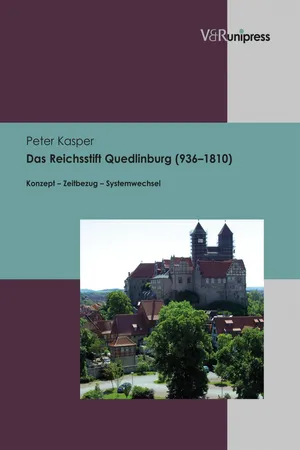
- 461 Seiten
- German
- PDF
- Über iOS und Android verfügbar
Über dieses Buch
The history of Quedlinburg's imperial convent was determined by the interdependency of varying conceptions and systemic conditions over the course of time. The foundation is exemplarily portrayed as a social system consisting of eight components and the fact that the convent survived the changing circumstances for nine hundred years was a result of this systemic structure. The convent established 'female rule' as a special type of government system. The burghers of the city adopted ideas from central Germany's cultural regions and the imperial convent transformed into a cultural small state in its own right. Prussia's power politics in the 18th century, the rise of the bourgeoisie and the shortcomings of the last abbesses led ultimately to the loss of imperial immediacy and to the closure of the by then secularised convent. The crisis in and the decline of the Holy Roman Empire, in comparison, played only a minor role.
Häufig gestellte Fragen
- Elementar ist ideal für Lernende und Interessierte, die gerne eine Vielzahl von Themen erkunden. Greife auf die Elementar-Bibliothek mit über 800.000 professionellen Titeln und Bestsellern aus den Bereichen Wirtschaft, Persönlichkeitsentwicklung und Geisteswissenschaften zu. Mit unbegrenzter Lesezeit und Standard-Vorlesefunktion.
- Erweitert: Perfekt für Fortgeschrittene Studenten und Akademiker, die uneingeschränkten Zugriff benötigen. Schalte über 1,4 Mio. Bücher in Hunderten von Fachgebieten frei. Der Erweitert-Plan enthält außerdem fortgeschrittene Funktionen wie Premium Read Aloud und Research Assistant.
Bitte beachte, dass wir keine Geräte unterstützen können, die mit iOS 13 oder Android 7 oder früheren Versionen laufen. Lerne mehr über die Nutzung der App.
Information
Inhaltsverzeichnis
- Title Page
- Copyright
- Table of Contents
- Body
- Vorwort
- I. Zum Forschungsstand
- II. Zur Methode
- I. Konzept: „memoria” und Repräsentation – Das ottonische Reichsstift als System zur Sicherung der Königsherrschaft (10. Jahrhundert.)
- II. Konzept: Landesherrschaft im dualen System (11.–15. Jahrhundert)
- III. Konzept: Reichsfürstin und christliche Obrigkeit – Säkularisierte Herrschaft und Konfessionalisierung (1495–1555)
- IV. Konzept: Landesherrschaft als Kondominat – Die Transformation des Systems (1539–1697)
- V. Konzept: Vorherrschaft des Schutzherrn – Die Destabilisierung des Systems (1698–1740)
- VI. Vom Fürstenstaat zum Staat der Bürger: Wirtschaft, Gesellschaft, Kultur
- VII. Konzept: Ausbau und Erosion des Herrschaftssystems (1740–1802)
- VIII. Konzept: Säkularisation und Mediatisierung – Modifikation des Systems (1802–1807)
- IX. Konzept: Konstitutioneller Staat und bürgerliche Gesellschaft – Die Auflösung des Systems (1807/08)
- X. Reformstaat oder Fremdherrschaft? – Die Herrschaftspraxis (1808–1813)
- XI. Ausblick
- I. Thesen
- II. Systemwechsel: Zeit und Konzept
- Anhang
- Quellen- und Literaturverzeichnis